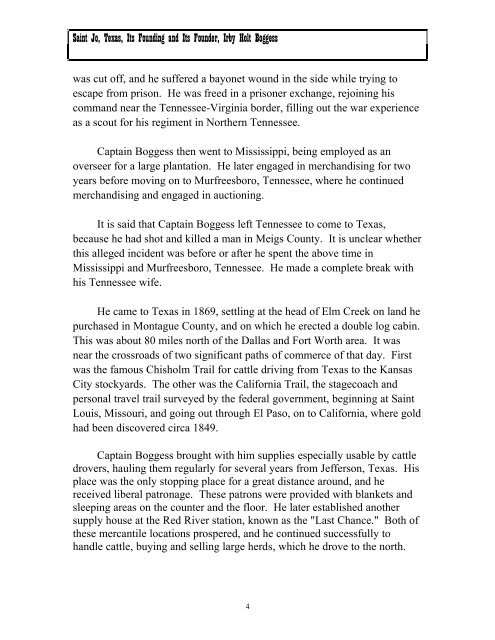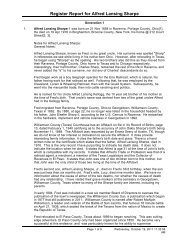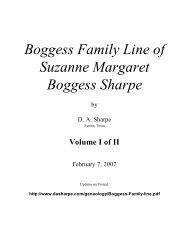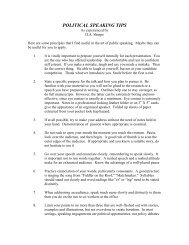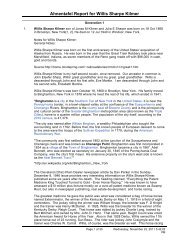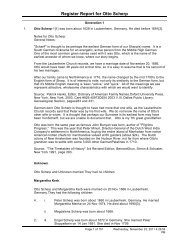The Saga of Irby Holt Boggess & his founding of St. Jo ... - D. A. Sharpe
The Saga of Irby Holt Boggess & his founding of St. Jo ... - D. A. Sharpe
The Saga of Irby Holt Boggess & his founding of St. Jo ... - D. A. Sharpe
Create successful ePaper yourself
Turn your PDF publications into a flip-book with our unique Google optimized e-Paper software.
Saint <strong>Jo</strong>, Texas, Its Founding and Its Founder, <strong>Irby</strong> <strong>Holt</strong> <strong>Boggess</strong><br />
was cut <strong>of</strong>f, and he suffered a bayonet wound in the side while trying to<br />
escape from prison. He was freed in a prisoner exchange, rejoining <strong>his</strong><br />
command near the Tennessee-Virginia border, filling out the war experience<br />
as a scout for <strong>his</strong> regiment in Northern Tennessee.<br />
Captain <strong>Boggess</strong> then went to Mississippi, being employed as an<br />
overseer for a large plantation. He later engaged in merchandising for two<br />
years before moving on to Murfreesboro, Tennessee, where he continued<br />
merchandising and engaged in auctioning.<br />
It is said that Captain <strong>Boggess</strong> left Tennessee to come to Texas,<br />
because he had shot and killed a man in Meigs County. It is unclear whether<br />
t<strong>his</strong> alleged incident was before or after he spent the above time in<br />
Mississippi and Murfreesboro, Tennessee. He made a complete break with<br />
<strong>his</strong> Tennessee wife.<br />
He came to Texas in 1869, settling at the head <strong>of</strong> Elm Creek on land he<br />
purchased in Montague County, and on which he erected a double log cabin.<br />
T<strong>his</strong> was about 80 miles north <strong>of</strong> the Dallas and Fort Worth area. It was<br />
near the crossroads <strong>of</strong> two significant paths <strong>of</strong> commerce <strong>of</strong> that day. First<br />
was the famous C<strong>his</strong>holm Trail for cattle driving from Texas to the Kansas<br />
City stockyards. <strong>The</strong> other was the California Trail, the stagecoach and<br />
personal travel trail surveyed by the federal government, beginning at Saint<br />
Louis, Missouri, and going out through El Paso, on to California, where gold<br />
had been discovered circa 1849.<br />
Captain <strong>Boggess</strong> brought with him supplies especially usable by cattle<br />
drovers, hauling them regularly for several years from Jefferson, Texas. His<br />
place was the only stopping place for a great distance around, and he<br />
received liberal patronage. <strong>The</strong>se patrons were provided with blankets and<br />
sleeping areas on the counter and the floor. He later established another<br />
supply house at the Red River station, known as the "Last Chance." Both <strong>of</strong><br />
these mercantile locations prospered, and he continued successfully to<br />
handle cattle, buying and selling large herds, which he drove to the north.<br />
4


